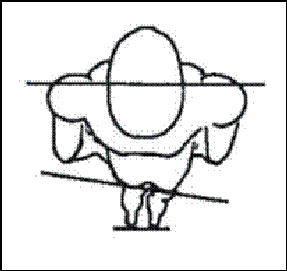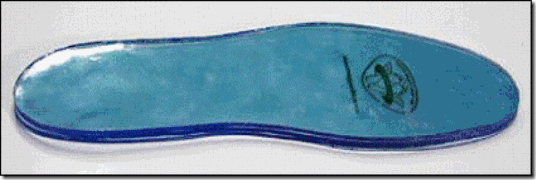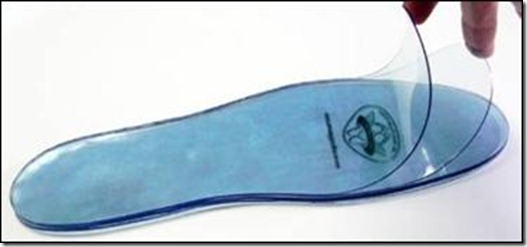Deed E. Harrison, DC
President CBP Seminars, Inc.
Vice President CBP Non-Profit, Inc.
Chair PCCRP Guidelines
Editor—AJCC
Introduction
The assessment of the patient with observed postural distortion and spine disorders would seem incomplete without the analysis of a weight bearing radiographic view of the pelvis and lumbar spine, including the femur heads. One of the more common structural findings in patients with lumbar spine disorders is the presence of an anatomical leg length inequality (ALLI). See Figure 1 for Postural Consequences of the ALLI. Although there is a significant body of literature discussing the epidemiology of ALLI, considerable controversy still exists over ALLI’s significance in patient populations with spinal disorders.1,2
In the CBP Lumbar Rehabilitation Textbook (2007),3 we presented a contemporary and complete review of the literature pertaining to ALLI and its biomechanical consequences, appropriate analysis, and interventions. In this current report, I would like to present a few recent investigations delineating some important findings regarding ALLI and its conservative treatment with lift intervention.
Figure 1. Typical Abnormal Posture Caused by a Left Anatomical Short Leg. In A (left photo), for a left ALLI, the thoracic cage will translate to the left side and laterally flex to the right. Often, the pelvis will translate slightly towards the side of ALLI (left in this case). In B (right photo), the pelvis will rotate anterior on the short leg side. If the shoulders and feet are aligned parallel, this means that the thorax has rotated posterior in the exact degrees that the pelvis rotated anterior. In other words, the thorax typically rotates posterior on the short leg side.
Recent Study #14
In a 2010 prospective study of 3026 patients 50-79 yrs of age, Harvey et al.4 sought to determine the correlation of ALLI to prevalent, incident and progression of knee osteo-arthritis (OA). They4 measured ALLI using full leg x-rays. Their findings are striking:
• ALLI ≥ 1 cm was associated with prevalent and symptomatic OA of knee. OR = 1.9
• The shorter leg had increased incident symptomatic and progressive OA of the Knee. OR = 1.5 & 1.3.
Conclusion: “Radiographic LLI was associated with prevalent, incident symptomatic, and progressive Knee OA. LLI is a potentially modifiable risk for Knee OA.”4
Recent Study #25
In a 2009 cohort study of 3012 people, Golightly and colleagues5 examined the relationship between chronic Knee and/or hip symptoms to ALLI. In 2006 of the subjects, there was an ALLI of ≥ 2 cm. Subjects in their sample with ALLI were statistically more likely to have knee symptoms (p<0.001). After adjusting for several confounding variables, knee symptoms were statistically associated with the presence of an ALLI (OR= 1.41 p< 0.001).
They5 stated, “LLI was moderately associated with chronic knee symptoms and less strongly associated with hip symptoms. LLI may be a new modifiable risk factor for therapy of people with knee or hip symptoms” .5
Orthotic Correction of ALLI Improves Chronic Pain
In a 2005 randomized trial, Defrin et al6 found statistically significant improvements in chronic low back pain in patients receiving shoe lifts compared to no treatment in the control subjects. In both the control and lift treatment groups, the measured LLI was between 5-10mm as measured via pelvic radiographs. This important study provides evidence that patients with chronic low back pain with concomitant ALLI between 5-10 mm may benefit from orthotic intervention aimed at leveling the sacral base and femur head heights. They stated,
“Shoe inserts appear to reduce CLBP and functional disability in patients with LLDs of 10mm or less”.
In 2007, Golightly et al7 reported on improvements in twelve (6 males and 6 females) consecutive chronic low back pain patients between the ages of 19-62 years of age with radiographic ALLI between 6.4-22.2 mm. Subjects were treated with orthotic intervention determined by the height that best relieved patient symptoms. Using the visual analog scale and disability questionnaires, statistically significant reductions in chronic pain intensity and disability scores were found.
Figure 2. Sole Supports full‐foot lifts are made of an easily cleanable, non‐compressible vinyl. If you are a Sole Supports certified provider, you receive a discounted rate for the full foot lift in combination with a Custom Orthotic order. However for non-Sole Supports certified providers, CBP Seminars has arranged to be a distributor for these innovative, contemporary, and biomechanically sound full-foot lifts. See www.idealspine.biz for details and ordering information.
New Full Length Shoe Lift for ALLI Correction From Sole Supports
An exciting product has just been launched on the market by Sole Supports as a new option for treatment of anatomical leg length inequality (ALLI). See Figure 2. This product is a full‐foot lift, made of non‐compressible vinyl and is available in 1mm peel able increments. Each lift consists of six, one‐millimeter layers of vinyl that allow you to adjust the height of the lift to suit your patient’s needs. See Figure 3.
Figure 3. Sole Supports Full Foot Lift. Each lift consists of six, one‐millimeter layers of vinyl that allow you to adjust the height of the lift to suit your patient’s individual needs. They are available in a range of both men’s and women’s sizes. The 6 mm size was chosen as a limit of what will generally fit in the average shoe.
Biomechanical Benefits of Full-Length Foot Lift
Problematically, the standard heel lift has a gradual taper being larger at the heel and smaller towards made foot. Though these tapered heal lifts have been found to be effective at relieving patients chronic pain syndromes, biomechanically there can be consequences to the functionality of the foot-ankle complex over long-term use.
Figure 4. Different types of shoe lifts available. Note that all of these lifts have a strong increased heel height and taper towards the mid-foot. Theoretically this taper may alter forefoot forces and heel-achilles tendon tightness due to ankle plantar flexion.
In contrast, use of the new full foot lift allows for correction of ALLI without changing ankle angulation or increasing plantar flexion of the foot; thus not compromising proper foot biomechanics. In theory, with a full‐foot lift, the foot will remain level (not considering the slope of the shoe itself) and the leg is lifted as a platform. The full foot lift would also limit changes in forefoot pressure and heel-achilles tendon tightness that can result because of ankle plantar flexion due to a tapered lift. These Sole Support full‐foot lifts should be used to address both acquired or functional leg length discrepancies, as well as anatomical discrepancies.
Editor’s Note: Sole Supports has graciously licensed CBP Seminars to distribute their innovative, contemporary, and biomechanically sound full-foot lifts. See www.idealspine.biz for details and ordering information.
References
- Knutson GA. Chiropractic & Osteopathy 2005;13(11):1-10.
- Brady RJ, Dean JB, Skinner MT, Gross MT. JOSPT 2003; 33:221-234.
- Harrison DE, Harrson DD, Haas JW, Oakley PA. Chapter 4. CBP Structural Rehabilitation of the Lumbar Spine. Evanston, WY: Harrison CBP Seminars, Inc., 2007.
- Harvey et al. Assoc of leg-length inequality with knee osteoarthritis. An Intern Med 2010; 152:287-95
5. Golightly et al. Symptoms of knee and hip in individuals with and without LLI. Osteoarthritis Cartilage 2009; 17: 596-600.
- Defrin R, et al. APMR 2005;86:2075-2080
- Golightly YM, Tate JJ, Burns CB, Gross MT. J Orthop Sports Phys Ther. 2007; 37(7):380-388.






